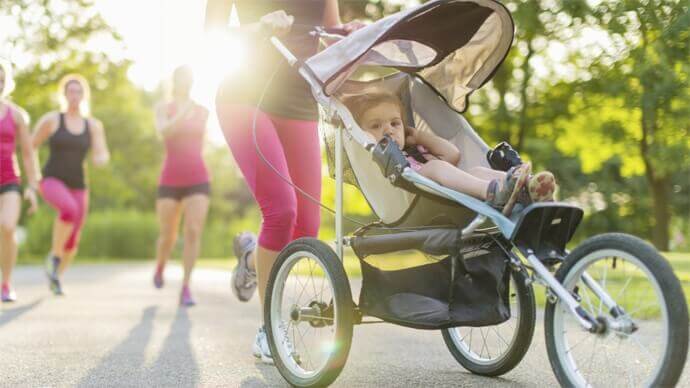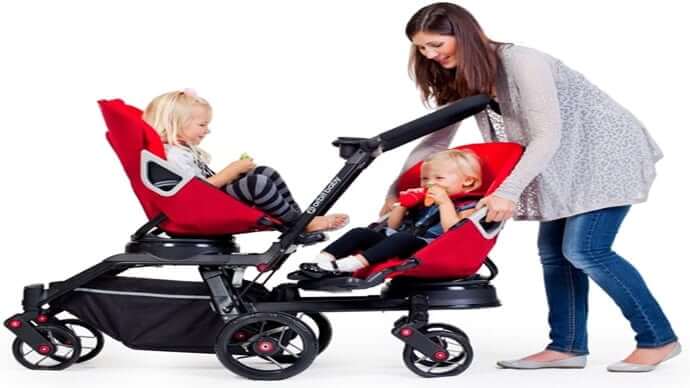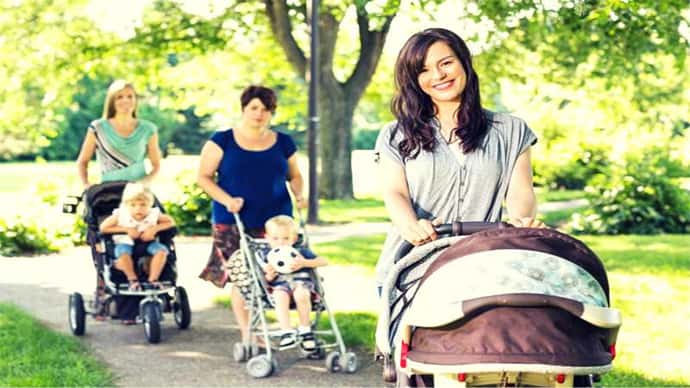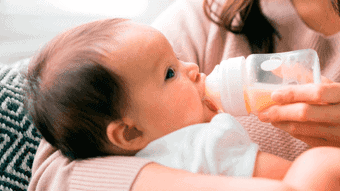It’s generally safe to start using a stroller without a car seat when your baby can sit up steadily on their own, typically around 6 to 8 months old.
Transitioning your baby from a car seat to a stroller without a car seat is an important milestone that requires careful consideration. Here is a detailed guideline to help you make this transition successfully:
| Aspect | Infant Stroller with Car Seat (Travel System) | Stroller Without Car Seat |
|---|---|---|
| Age Suitability | Suitable for infants from birth to 12 months | More suitable for older infants and toddlers |
| Developmental Milestones | Accommodates infants with limited head control | Ideal for babies who can sit upright independently |
| Safety Features | Focuses on easy transition from car to stroller | Offers more spacious seating and upright position |
| Weight Limit | Typically designed for infants up to 12 months | Check weight limit before use |

- Age and Developmental Milestones: Manufacturers typically recommend waiting until your baby is around six months old before placing them in a stroller seat without a car seat. This recommendation aligns with critical developmental milestones like gaining head control, sitting up unassisted, and having sufficient neck and back muscle strength to maintain an upright position.
- Safety Considerations: Before transitioning your baby to a stroller without a car seat, ensure that they can sit upright independently and have good head control. This usually occurs between 4 and 7 months of age. It’s crucial to prioritize safety by checking the weight limit of the stroller and considering your baby’s overall development
- Signs of Readiness: Watch for signs that indicate your baby is ready for a stroller without a car seat, such as improved head control, the ability to sit unaided, showing interest in surroundings, and discomfort in the car seat
Key Takeaways:
- Wait until your baby is around six months old and shows signs of improved head control and ability to sit upright independently before using a stroller without a car seat.
- Prioritize safety by checking the weight limit of the stroller and ensuring your baby is developmentally ready for the transition.
- Look for cues like improved head control, independent sitting, interest in surroundings, and discomfort in the car seat to gauge your baby’s readiness for a stroller without a car seat.
Safety Risks of Putting a Baby in a Stroller Without a Car Seat
Transitioning your baby from a car seat to a stroller is an exciting milestone, but it’s essential to understand the potential safety risks involved. When using a stroller without a car seat, your baby is not securely strapped in like they are in a car seat, putting them at higher risk for injury.
Without the proper restraints, your baby may slip out of the stroller or be ejected during sudden stops or turns. This can lead to serious injuries, including head trauma or broken bones. Additionally, if the stroller is not designed to support your baby’s head and neck, it can cause suffocation or spinal injuries.
It’s crucial to ensure that the stroller you choose is appropriate for your baby’s age, weight, and development and meets all safety standards. Without proper research and consideration, you may inadvertently put your baby at risk of injury.
To avoid these safety risks, it’s recommended to use a car seat for infants until they can sit up unassisted, around six months old. After that, you can transition your baby to a stroller that includes a secure harness, headrest, and appropriate recline settings.
Safety Risks of Putting a Baby in a Stroller Without a Car Seat
| Risk | Potential Injury |
|---|---|
| Slipping out of the stroller | Head trauma, broken bones |
| Ejection during sudden stops or turns | Head trauma, broken bones |
| Insufficient head and neck support | Suffocation, spinal injuries |
Transitioning from Car Seat to Stroller
Transitioning your baby from a car seat to a stroller can seem daunting, but it can be a smooth process with the right approach. Follow these steps to ensure a safe and comfortable transition for your little one:
- Check the weight and height limits: Before transitioning your baby from a car seat to a stroller, make sure they meet the weight and height requirements for the stroller. Opt for a stroller with a five-point harness system and adjustable recline options for added safety and comfort.
- Start with short stroller rides: Begin by taking short trips in the stroller to get your baby used to the new environment. Gradually increase the duration of the outings as your baby becomes more comfortable.
- Practice proper stroller handling: It’s important to know how to properly handle and maneuver the stroller before putting your baby in it. Practice adjusting the harness, reclining the seat, and folding and unfolding the stroller to avoid any mishaps with your baby inside.
- Monitor for signs of discomfort: As with any new experience, your baby may experience discomfort or fussiness during the transition. Monitor your baby for signs of discomfort, such as crying or restlessness, and adjust the stroller as needed to ensure their comfort.
- Maintain proper posture: Make sure your baby is properly positioned in the stroller to avoid any posture-related issues. Use a stroller with a comfortable and supportive seat that allows for proper spinal alignment.
- Gradually phase out the car seat: Once your baby is comfortable in the stroller, gradually reduce their reliance on the car seat. Begin by using the car seat less frequently during stroller outings, and eventually phase it out entirely.
By following these guidelines, you can successfully transition your baby from a car seat to a stroller without compromising their safety or comfort.
Different Types of Strollers that Can be Used without a Car Seat
When it comes to strollers that can be used without a car seat, there are several options available to you. Each type of stroller has its own unique features and benefits, so it’s important to choose one that fits your lifestyle and needs.
Umbrella Stroller
Umbrella strollers are lightweight and compact, making them ideal for travel or navigating through crowded areas. They usually have a simple design, with a basic reclining seat and a canopy for sun protection. However, they typically lack many of the features found in larger strollers, such as storage baskets, adjustable handles, or cup holders.
Jogging Stroller
Jogging strollers are designed for parents who enjoy an active lifestyle. They have three large wheels (one in the front and two in the back), which provide stability and maneuverability on various terrains. These strollers usually have a more substantial frame and a long wheelbase, which can make them heavier and bulkier than other types of strollers.
Best Jogging Stroller Review and Expert Guide
Best Double stroller For Twins
Best Umbrella stroller for All Uses
All-Terrain Stroller
All-terrain strollers are similar to jogging strollers but designed for off-road adventures. They have large, air-filled tires, and a durable suspension system, which allows them to handle rocky or uneven surfaces. These strollers are usually heavier and bulkier than other types of strollers, but they provide a smooth ride for your baby.
Standard Stroller
Standard strollers are the most popular type of stroller and come in various designs and styles. They have four wheels and often come with additional features such as storage baskets, adjustable handles, and cup holders. Standard strollers are typically heavier and bulkier than umbrella strollers, but they provide more comfort and convenience for your baby.
Double Stroller
Double strollers are designed for parents with two children. They come in various configurations, including side-by-side or tandem (one child in front of the other). Double strollers can be heavy and bulky, but they provide a convenient way to transport both children at once.
| Type of Stroller | Pros | Cons |
|---|---|---|
| Umbrella Stroller | Lightweight, compact, easy to maneuver | Lacks many features of larger strollers |
| Jogging Stroller | Great for active parents, stable and maneuverable on various terrains | Can be heavy and bulky, not suitable for everyday use |
| All-Terrain Stroller | Handles off-road adventures well, provides a smooth ride for your baby | Can be heavy and bulky, not suitable for everyday use |
| Standard Stroller | Comes with additional features and convenience, provides more comfort for your baby | Heavier and bulkier than umbrella strollers |
| Double Stroller | Convenient way to transport two children at once | Can be heavy and bulky |
Ultimately, the type of stroller you choose will depend on your lifestyle, budget, and personal preferences. It’s important to choose a stroller that provides a comfortable and safe ride for your baby, and that meets the safety standards set by the AAP and other regulatory bodies. Consider any special needs or features that you require, such as a travel system, adjustable handles, or a reclining seat, when making your decision.
Safety Standards for Strollers and Car Seats
The safety of your baby is of utmost importance, which is why it’s essential to understand the safety standards for strollers and car seats. Here are some important things to keep in mind:
Stroller Safety Standards:
| Safety Standard | Description |
|---|---|
| JPMA Certification | The Juvenile Products Manufacturers Association (JPMA) certifies strollers that meet safety standards set by ASTM International. |
| Brakes | Strollers should have a reliable braking system to prevent them from rolling away. |
| Recline | Strollers should have a recline feature to support your baby’s head and body. |
| Harness | Strollers should have a five-point harness to keep your baby secure and prevent them from slipping out of the seat. |
Car Seat Safety Standards:
| Safety Standard | Description |
|---|---|
| Federal Motor Vehicle Safety Standard (FMVSS) 213 | This is the safety standard for child restraint systems set by the National Highway Traffic Safety Administration (NHTSA). |
| Expiration Date | All car seats have an expiration date, after which they should no longer be used due to safety concerns. |
| Installation | Car seats should be properly installed in the back seat of your vehicle, following the manufacturer’s instructions and your vehicle’s owner manual. |
When purchasing a stroller or car seat, look for products that comply with these safety standards to ensure your baby’s well-being.
Factors to Consider for Putting Your Baby in a Stroller Without a Car Seat
Before putting your baby in a stroller without a car seat, there are several factors you should consider to ensure their safety:
- Age: Your baby should be able to sit upright and have good head control before using a stroller without a car seat. This typically happens around 6 months of age.
- Weight: Check the weight limit of the stroller before putting your baby in it. Ensure that your baby’s weight falls within the recommended limit.
- Development: Consider your baby’s overall development to determine if they are ready to transition to a stroller without a car seat.
- Duration of use: Determine how long you will be using the stroller and if it is safe for your baby to spend that amount of time without a car seat.
- Location: Consider the location where you will be using the stroller, as some terrains may require a sturdier stroller or a car seat.
By taking these factors into account, you can make an informed decision about when it is safe to use a stroller without a car seat for your baby.
Recommended Age and Weight Limits for Using a Stroller Without a Car Seat
It’s important to be aware of the recommended age and weight limits for using a stroller without a car seat to ensure your baby’s safety. According to the American Academy of Pediatrics (AAP), infants under six months old should always be in a rear-facing car seat. Once your baby reaches six months of age and can sit up unsupported, they can safely ride in a stroller without a car seat.
The AAP also recommends that babies should be able to hold their head up steadily before being placed in a stroller without a car seat. This is usually around three to six months of age, depending on your baby’s development.
When it comes to weight limits, most strollers have a maximum weight capacity of around 50 pounds. However, it’s important to check the manufacturer’s guidelines for your specific stroller to ensure that you are using it within the recommended weight limit and not exceeding the capacity.
Remember, even if your baby meets the recommended age and weight limits for a stroller, it’s important to always prioritize their safety. Be sure to check that your stroller meets safety standards and follow proper safety measures, such as using the harness and recline features correctly.
Ensuring Proper Safety Measures when Using a Stroller without a Car Seat
Putting your baby in a stroller without a car seat requires extra vigilance and attention to safety measures. Here are some tips to ensure your baby’s safety:
- Make sure the stroller has a good braking system and use it when stopping or parking the stroller.
- Ensure the stroller has a sturdy frame and is not at risk of tipping over.
- Secure your baby with the harness and ensure it is adjusted properly. The harness should be snug enough to keep your baby securely in the stroller but not so tight that it causes discomfort.
- Check the recline of the stroller to ensure your baby’s head and neck are supported. Newborns and younger babies may need a flat recline, while older babies may prefer a more upright position.
- Do not hang heavy bags or items on the handles of the stroller as this can cause it to become unstable.
- Avoid using an umbrella stroller for a baby under six months old as they do not provide enough support.
In addition to these guidelines, always use your best judgment and stay alert to your baby’s comfort and safety when using a stroller without a car seat.
Considerations for Tall or Heavy Babies in a Stroller:
If you have a tall or heavy baby, using a stroller without a car seat requires additional considerations to ensure their comfort and safety. First, make sure the stroller can accommodate your baby’s weight and size. Look for strollers with a weight limit of at least 50 pounds and a seat width of at least 14 inches to comfortably fit your little one.
Next, consider the stroller’s handlebar height. If you or your partner is tall, look for a stroller with adjustable handlebars to prevent back pain and discomfort during long walks. Additionally, make sure the stroller’s harness fits securely around your baby’s shoulders and waist, even if they are taller or heavier than average.
Finally, check the stroller’s wheels and suspension system. A stroller with larger wheels and better suspension can handle a heavier weight and provide a smoother ride for your baby. Remember to always follow the weight and height limits specified by the manufacturer to ensure your baby’s safety while using a stroller without a car seat.
The Importance of Proper Stroller Recline and Harness
When using a stroller without a car seat, it’s crucial to ensure that your baby is in the correct recline position and secured with the proper harness. This will help prevent your baby from sliding out of the stroller or experiencing any discomfort during the ride.
The recline position of the stroller should be adjusted according to your baby’s age and weight. For newborns and younger babies, the stroller should be set in a fully reclined position so that your baby’s head and neck are supported. As your baby grows, you can gradually adjust the stroller to a more upright position.
The harness of the stroller should also be adjusted to fit your baby securely. It should be snug but not too tight, with the straps adjusted to fit your baby’s shoulders and waist correctly. The harness should be fastened every time you use the stroller, even for short trips.
Remember to always check that the harness and recline position of the stroller are properly adjusted before putting your baby into the stroller. This will help ensure your baby’s comfort and safety during the ride.
By following these safety tips, you can feel confident in using a stroller without a car seat for your baby.
Transitioning to a Convertible Car Seat
When your baby outgrows their infant car seat, it’s time to transition to a convertible car seat. This type of car seat can accommodate your child’s growth and development up to their toddler years. The transition from a stroller to a car seat can be tricky, but with some careful planning and preparation, it can be a smooth experience.
Before purchasing a convertible car seat, ensure that it meets all safety standards. Look for features such as a five-point harness, side-impact protection, and an adjustable headrest to provide the best possible protection for your baby.
It’s important to note that convertible car seats are not suitable for newborns, and you should continue to use an infant car seat until your baby reaches the appropriate weight and height limit. When it’s time to make the switch, follow the manufacturer’s instructions carefully to ensure that the car seat is installed correctly.
Transitioning from a stroller to a car seat can be overwhelming for both you and your baby. Start by introducing your baby to the car seat while still at home, allowing them to explore and get comfortable with it. Once they are used to the car seat, practice short car rides to help them adjust to being in a seated position for an extended period.
Remember to always buckle your baby into their car seat correctly and ensure that the straps are snug and secure. Avoid using bulky clothing or blankets that could interfere with the proper fit of the harness.
In conclusion, transitioning to a convertible car seat requires careful planning and preparation. Always prioritize your baby’s safety by choosing a car seat that meets all safety standards and ensuring that it is installed correctly. With a little patience and practice, you and your baby can smoothly transition from a stroller to a car seat.
Conclusion
Congratulations on successfully navigating the world of strollers and car seats! By now, you should have a good understanding of when it’s safe to put your baby in a stroller without a car seat, as well as the different types of strollers available and how to ensure your baby’s safety.
Remember, safety should always be your top priority when it comes to your baby. Be sure to follow the recommended age and weight limits for using a stroller without a car seat and familiarize yourself with the safety standards for both strollers and car seats. And don’t forget to properly adjust the stroller’s recline and harness settings to ensure maximum comfort and safety for your little one.
If you have a tall or heavy baby, be sure to take note of the additional considerations mentioned in this guide. And when it’s time to transition to a convertible car seat, remember to take it slow and don’t rush the process.
By applying these safety tips and guidelines, you can confidently enjoy your baby’s stroller journey without any worry or fear. Happy strolling!







